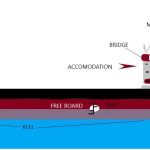To construct a ship that floats when immersed water, marine engineers and naval architects rely on the Archimedes principle. This principle describes an upward buoyant force that is exerted on a body that is fully or partially immersed in a fluid, which is equal to the weight of the fluid displaced by the body. This buoyant force acts at the centre of mass of the displaced fluid and in the upward direction. For an object to float in water, the amount of water it displaces should be equal to the weight of the object.
This volume of water which is displaced by a ship depends not only on the weight of the object but also on its shape and size. It can be observed that an iron nail sinks in water, while the same material (iron) arranged in different size and form, i.e. a boat or ship, floats in water.
We can see that if the construction of the structure is such that the density of the vessel is less than that of water, the ship will float in water. Hence a seaworthy steel vessel will have a lower average density than water, which enables it to float. The shipbuilders also have to consider the intact stability and damage stability while designing the ship.
Disclaimer: The authors’ views expressed in this article do not necessarily reflect the views of Marine Insight. Data and charts, if used, in the article have been sourced from available information and have not been authenticated by any statutory authority. The author and Marine Insight do not claim it to be accurate nor accept any responsibility for the same. The views constitute only the opinions and do not constitute any guidelines or recommendation on any course of action to be followed by the reader.


